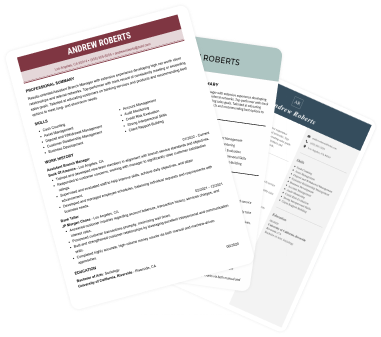Create a professional CV now!
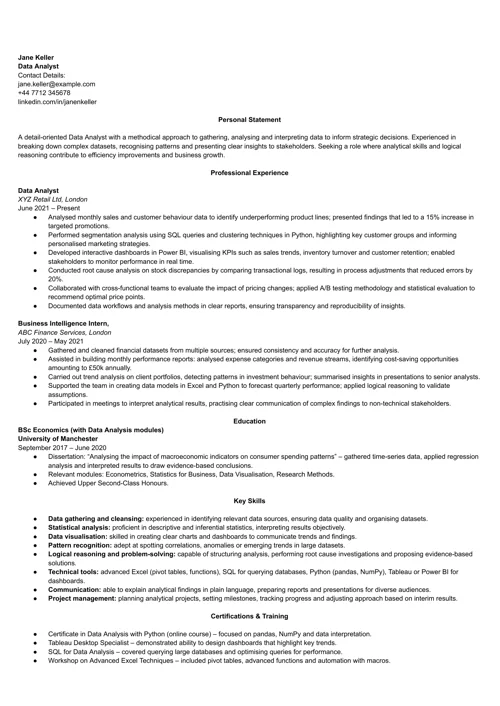 NO
NO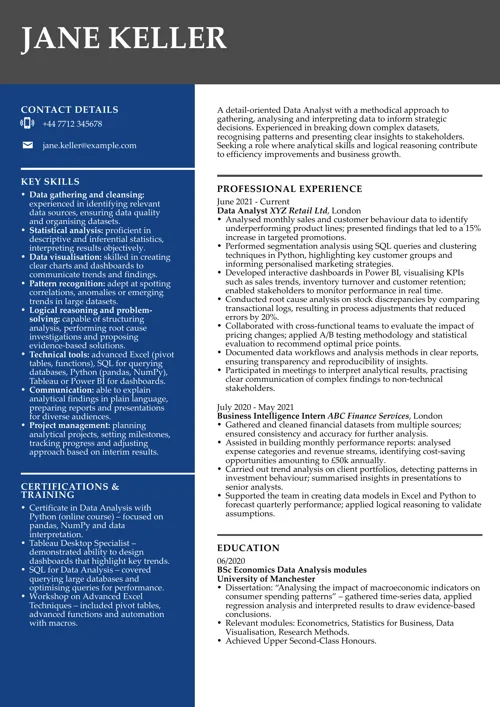 YES
YESLast updated on 13 November, 2025

In a complex and rapidly changing environment, analytical thinking allows us to understand issues methodically and make informed decisions. By breaking down information, recognising patterns, and weighing evidence, individuals achieve clarity amid uncertainty and navigate challenges with confidence.
But what’s the definition of analytical thinking? Is it the same as critical thinking? And how can you improve your analytical thinking? Let me answer all these questions for you and tell you everything you need to know about analytical thinking.
In this article:
Create an effective CV in minutes. Choose a professional CV template and fill in every section of your CV in a flash using ready-made content and expert tips.
Create a professional CV now!
 NO
NO YES
YESWe created the sample on the right using our builder. See other good CV examples like this one.
Analytical thinking refers to the ability to break down and systematically examine information to understand it thoroughly. It involves various mental processes, such as collecting information, identifying patterns, and verifying facts, rather than relying solely on intuition.
Analytical reasoning is a valuable hard skill that is essential in both everyday life and the workplace. It forms the foundation for decision-making, critical thinking, problem-solving, and even communication in various contexts. It’s also a component of analytical skills that provides a structured framework for comprehension before action.
Analytical and critical thinking serve different yet complementary purposes. Analytical thinking seeks to understand how things function by examining details and mechanisms. Critical thinking, in contrast, questions whether those mechanisms and conclusions are valid and appropriate.
Both approaches are vital in decision-making, as gathering information alone is inadequate without also evaluating its reliability. Recognising when to analyse and when to assess aids in forming balanced judgements.
Let’s break down this difference in a more detailed way:
|
|
Analytical thinking |
|
Critical thinking |
|
Goal |
To explain how things work by identifying underlying mechanisms. |
|
To assess whether those mechanisms or conclusions are valid and fit their purpose. |
|
Focus |
To concentrate on details and divide problems into manageable parts. |
|
To adopt a broader perspective, questioning assumptions and implications. |
|
Method |
By systematically organising and analysing data. |
|
By probing premises, uncovering biases and considering alternative viewpoints. |
|
Result |
Produces structured insights and a deeper understanding. |
|
Leads to well-reasoned judgements and informed choices. |
Understanding these differences ensures that you won’t stop at gathering information, but also reflect on its validity and relevance before taking action.
Analytical thinking relies on a related set of skills that facilitate a thorough examination of information. Each skill builds on the previous one, from gathering reliable data to sharing findings effectively.
Here are the key aspects of analytical thinking:
Analytical thinking begins by identifying key components and tackling each in turn to avoid feeling overwhelmed. Asking questions such as “What are the main factors?” or “Which part should I examine first?” helps structure the approach effectively. This ensures a clear path through complexity.
Identifying trends or recurring themes in data or experience, and noting links that may not be immediately apparent, is also an essential aspect of analytical thinking. Keeping a record of observations helps reveal connections over time. This practice uncovers insights that guide further analysis.
Another element of analytical thinking is collecting relevant facts from reliable sources and arranging them logically, for example, in tables, lists or simple diagrams. Noting the origin and context of each item aids later verification. Well-organised information forms a solid basis for the next steps.
Examining evidence without rushing to conclusions is crucial for practical analytical thinking. Always be aware of your assumptions and blind spots. Where possible, test or cross-check data before relying on it. This cautious stance reduces errors and bias.
Analytical thinkers combine findings from different components into a coherent account or model that explains how the parts relate to one another. Highlighting any uncertainties or gaps that may require further investigation leads to a clear synthesis that guides sound understanding.
Logic plays a significant role in analytical thinking. That’s why it’s necessary to ensure each inference follows directly from the organised evidence rather than instinct alone. Stay ready to revise conclusions if new facts emerge. This flexibility keeps reasoning accurate.
Analytical thinking requires an essential soft skill: the ability to communicate clearly. Present outcomes in a structured manner through concise reports, simple charts, or straightforward explanations, allowing others to follow the logic. Emphasise key points and any limitations to direct attention to the most significant insights. Clear communication fosters understanding and support.
By refining these elements and referring back to them when analysing a task, you establish a dependable process that reduces mistakes and
A strong CV summary will convince the recruiter you’re the perfect candidate. Save time and choose a ready-made personal statement written by career experts and adjust it to your needs in the LiveCareer CV builder.
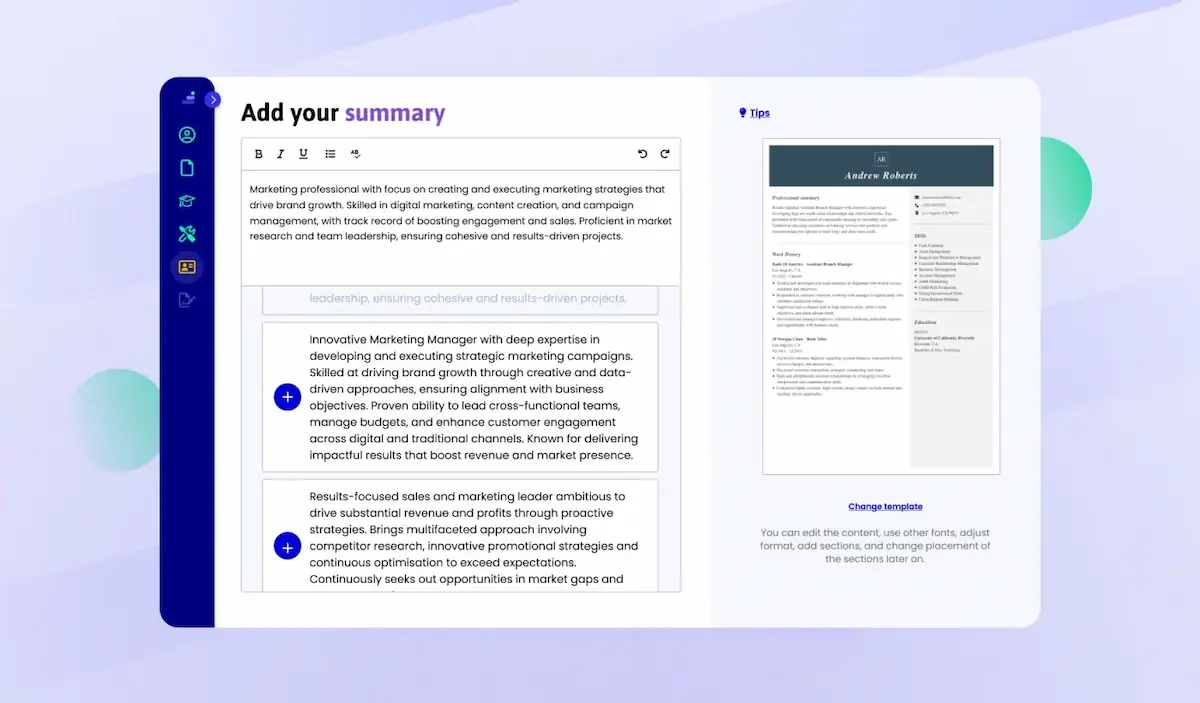
There are many popular skills to show during a recruitment process. But did you know that analytical thinking is considered the number 1 skill recruiters are looking for? And no wonder. After all, adopting an analytical approach brings tangible advantages in every aspect of one’s life. Over time, a habit of clear analysis accelerates problem resolution and enhances outcomes.
Let’s see what some other benefits of analytical thinking are:
Analytical thinking enables you to break down issues into smaller components, facilitating accurate diagnosis of underlying causes. By structuring the problem step by step, you can devise targeted remedies instead of relying on superficial fixes. This methodical approach ensures that solutions tackle root causes and minimise the likelihood of recurring problems.
When you base decisions on organised data and objective evaluation, your choices become more reliable, leaving less room for regret or second-guessing. Analytical thinking encourages you to compare evidence against clear criteria, which helps to exclude impulsive alternatives. As a result, you feel more confident in your conclusions and can justify them effectively to others.
Concentrating effort on the most relevant tasks and information helps cut through distractions and prevent wasted work. By organising data clearly, you avoid duplication and confusion, resulting in time savings and improved productivity. Analytical habits enable you to quickly identify priorities and allocate resources where they are most needed.
Examining a topic methodically uncovers nuances that might otherwise be overlooked and accelerates learning when confronted with new subjects. By breaking a complex area into logical segments and exploring each in detail, you construct a more comprehensive picture. This in-depth understanding not only deepens knowledge but also reveals any gaps that require further investigation.
Presenting structured insights enables colleagues and stakeholders to follow your reasoning, thereby fostering collaboration and trust. Clearly explaining how you arrived at your conclusions, including any uncertainties and sources of evidence, invites constructive dialogue. This transparency aligns teams around a shared understanding and facilitates the implementation of agreed actions.
A thorough analysis uncovers warning signs early, allowing for preventive measures before issues escalate. By documenting assumptions and examining scenarios in detail, one can revisit and revise them as conditions change. This proactive approach minimises surprises and supports more resilient planning.
An analytical mindset simplifies the updating of models or plans when new information becomes available, ensuring they remain relevant and responsive. Monitoring patterns and relationships enables you to identify shifts quickly and adjust accordingly. This flexibility ensures that decisions and strategies remain aligned with current realities.
These advantages accumulate: as you apply analytical habits in varied situations, you become quicker at recognising which element to use and how it leads to concrete improvements.
Real-world scenarios demonstrate how the elements translate into practical applications. These instances span various fields but share a common, structured approach.
Here are the analytical thinking examples in action:
Analytical skills can be learned and strengthened over time. Regular practice and reflection help make structured analysis a habit rather than a one-off effort. Simple exercises, tools and habits support gradual improvement without adding undue effort.
Here are my top strategies that will help you build confidence in your analytical thinking:
Ask how and why things work beneath the surface. Adopting a learning mindset encourages deeper inquiry instead of accepting first impressions. Over time, habitual questioning uncovers subtleties that enrich your understanding and guide more thorough analysis.
Use established methods such as SWOT analysis, root cause analysis or the “5 Whys” to dissect issues systematically. These frameworks prompt you to examine different angles and guard against overlooking critical factors. Regular application familiarises you with orderly steps and reduces reliance on intuition alone.
Work on puzzles, logic challenges or case studies at intervals, focusing on the reasoning process rather than just the solution. After each exercise, reflect on which steps felt natural and which exposed gaps. This deliberate reflection highlights areas for improvement and fosters analytical habits.
Learn to read charts, interpret basic statistics and navigate spreadsheets or simple data-visualisation tools. Understanding how information is represented helps you organise evidence effectively. As familiarity grows, you can spot anomalies or trends more quickly and base conclusions on solid evidence.
Discuss topics with colleagues or mentors who may notice aspects you miss. Exposure to different viewpoints can reveal hidden assumptions or fresh connections. Incorporating varied input strengthens your analysis and reduces the risk of biased conclusions.
Keep brief notes on findings, sources and reasoning steps when exploring a topic. Reviewing past entries shows how your thinking has evolved and highlights methods that worked well. This record also serves as a reference when similar challenges arise in the future, thereby speeding up subsequent analysis.
When reviewing articles or reports, focus on the methodology, sample size, and potential biases. Distinguish factual claims from opinion and assess the credibility of each source. Sharp reading skills ensure that the information you gather for analysis is reliable and relevant.
Create simple diagrams, flowcharts or mind maps to map relationships among factors. Visual representation often clarifies complex interconnections more quickly than text alone. Regularly drawing these aids trains you to see structure in information and to explain your reasoning more clearly.
After completing a project or analysis, pause to reflect on what went well and what could be improved. Reflect on decision points, alternatives you did not explore and any assumptions that affected outcomes. This habit turns each exercise into a learning opportunity, refining your approach for next time.
Use analytical tools, such as data-modelling software or visualisation platforms, to support your thinking, but remain aware of their limitations. Ensure outputs align with the real-world context and do not accept results uncritically. Thoughtful use of technology amplifies your skills without replacing the need for careful judgment.
By applying these strategies deliberately and consistently, individuals can refine their analytical approach and tackle increasingly complex problems.
You don’t have to be a CV writing expert. In the LiveCareer CV builder you’ll find ready-made content for every industry and position, which you can then add with a single click.
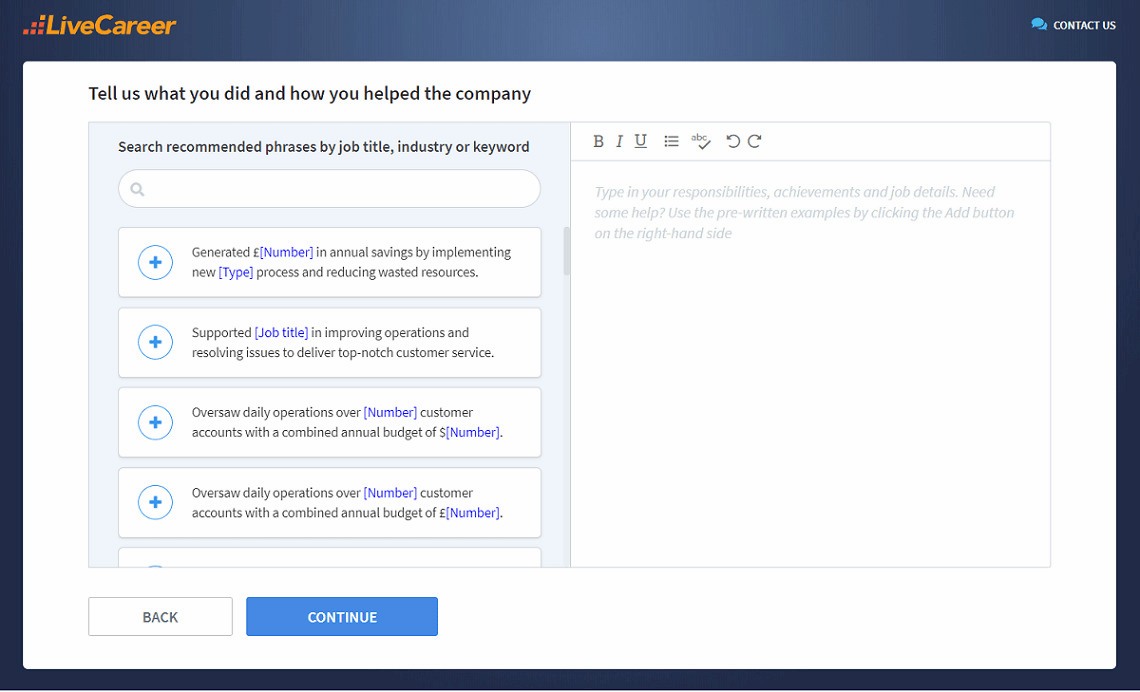
And that’s it. Now that you know everything you need about analytical thinking, it’s time to apply it in your day-to-day life. Good luck!
Are you looking for more skill-based articles? Visit our guides:
Our editorial team has reviewed this article for compliance with Livecareer’s editorial guidelines. It’s to ensure that our expert advice and recommendations are consistent across all our career guides and align with current CV and cover letter writing standards and trends. We’re trusted by over 10 million job seekers, supporting them on their way to finding their dream job. Each article is preceded by research and scrutiny to ensure our content responds to current market trends and demand.
Category: Career Advice
Crafting a job-winning CV is all about showcasing your unique skills and experiences. Start with a strong personal statement that highlights your career goals and achievements.
Try Our CV Builder Now